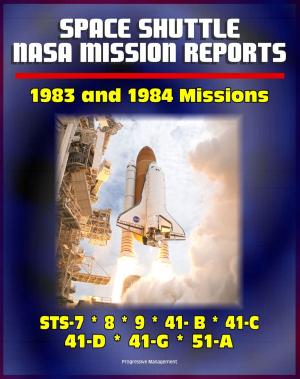Apollo and America's Moon Landing Program: Apollo 12 Official NASA Mission Reports and Press Kit - 1969 Second Lunar Landing by Astronauts Conrad, Gordon, and Bean
Nonfiction, Science & Nature, Science, Physics, Astronomy, History, Americas| Author: | Progressive Management | ISBN: | 9781465952820 |
| Publisher: | Progressive Management | Publication: | November 24, 2011 |
| Imprint: | Smashwords Edition | Language: | English |
| Author: | Progressive Management |
| ISBN: | 9781465952820 |
| Publisher: | Progressive Management |
| Publication: | November 24, 2011 |
| Imprint: | Smashwords Edition |
| Language: | English |
Three comprehensive official NASA documents - converted for accurate flowing-text e-book format reproduction - chronicle the amazing journey of Apollo 12, which performed the second manned lunar landing in November 1969. It was conducted by astronauts Conrad, Gordon, and Bean.
Two technical mission reports, the Manned Spacecraft Center (MSC) Apollo Mission Report and the NASA Headquarters Mission Operation Report (MOR), provide complete details about every aspect of the mission.
Apollo 12 MSC Mission Report: Mission description, pilots' report, communications, trajectory, command and service module performance, mission support performance, assessment of mission objectives, launch vehicle summary, anomaly summary (CSM, LM, government furnished equipment), conclusions, vehicle descriptions. Apollo 12 MOR: Mission design and execution, spacecraft performance, flight anomalies, detailed objectives and experiments, launch countdown, detailed flight mission description, back contamination program, contingency operations, configuration differences, mission support, recovery support plan, flight crew, mission management responsibility, program management, abbreviations and acronyms. Apollo 12 Press Kit: Detailed preview from countdown to landing.
The Apollo 12 mission provided a wealth of scientific information in this significant step of detailed lunar exploration. The emplaced experiments, with an expected equipment operation time of 1 year, will enable scientific observations of the lunar surface environment and determination of structural perturbations. This mission demonstrated the capability for a precision landing, a requirement for proceeding to more specific and rougher lunar surface locations having particular scientific interest.
The space vehicle, with a crew of Charles Conrad, Jr., Commander; Richard F. Gordon, Command Module Pilot; and Alan L. Bean, Lunar Module Pilot; was launched from Kennedy Space Center, Florida, at 11:22:00 a.m. e.s.t. (16:22:00 G.m.t.) November 14, 1969. The activities during earth-orbit checkout, translunar injection, and translunar coast were similar to those of Apollo 11, except for the special attention given to verifying all spacecraft systems as a result of lightning striking the space vehicle at 36.5 seconds and 52 seconds. A non-free-return translunar trajectory profile was used for the first time in the Apollo 12 mission.
The spacecraft was inserted into a 168.8- by 62.6-mile lunar orbit at about 83-1/2 hours. Two revolutions later a second maneuver was performed to achieve a 66.1- by 54.3-mile orbit. The initial checkout of lunar module systems during translunar coast and in lunar orbit was satisfactory. At about 104 hours, the Commander and the Lunar Module Pilot entered the lunar module to prepare for descent to the lunar surface.
Three comprehensive official NASA documents - converted for accurate flowing-text e-book format reproduction - chronicle the amazing journey of Apollo 12, which performed the second manned lunar landing in November 1969. It was conducted by astronauts Conrad, Gordon, and Bean.
Two technical mission reports, the Manned Spacecraft Center (MSC) Apollo Mission Report and the NASA Headquarters Mission Operation Report (MOR), provide complete details about every aspect of the mission.
Apollo 12 MSC Mission Report: Mission description, pilots' report, communications, trajectory, command and service module performance, mission support performance, assessment of mission objectives, launch vehicle summary, anomaly summary (CSM, LM, government furnished equipment), conclusions, vehicle descriptions. Apollo 12 MOR: Mission design and execution, spacecraft performance, flight anomalies, detailed objectives and experiments, launch countdown, detailed flight mission description, back contamination program, contingency operations, configuration differences, mission support, recovery support plan, flight crew, mission management responsibility, program management, abbreviations and acronyms. Apollo 12 Press Kit: Detailed preview from countdown to landing.
The Apollo 12 mission provided a wealth of scientific information in this significant step of detailed lunar exploration. The emplaced experiments, with an expected equipment operation time of 1 year, will enable scientific observations of the lunar surface environment and determination of structural perturbations. This mission demonstrated the capability for a precision landing, a requirement for proceeding to more specific and rougher lunar surface locations having particular scientific interest.
The space vehicle, with a crew of Charles Conrad, Jr., Commander; Richard F. Gordon, Command Module Pilot; and Alan L. Bean, Lunar Module Pilot; was launched from Kennedy Space Center, Florida, at 11:22:00 a.m. e.s.t. (16:22:00 G.m.t.) November 14, 1969. The activities during earth-orbit checkout, translunar injection, and translunar coast were similar to those of Apollo 11, except for the special attention given to verifying all spacecraft systems as a result of lightning striking the space vehicle at 36.5 seconds and 52 seconds. A non-free-return translunar trajectory profile was used for the first time in the Apollo 12 mission.
The spacecraft was inserted into a 168.8- by 62.6-mile lunar orbit at about 83-1/2 hours. Two revolutions later a second maneuver was performed to achieve a 66.1- by 54.3-mile orbit. The initial checkout of lunar module systems during translunar coast and in lunar orbit was satisfactory. At about 104 hours, the Commander and the Lunar Module Pilot entered the lunar module to prepare for descent to the lunar surface.















